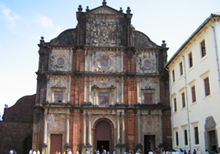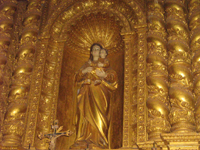|
 This world
heritage monument built in 1605 is a fine example of Jesuit architecture
and has emerged as a landmark in the history of Christianity. It is situated
in Old Goa, 9kms from the Capital Panjim. It is a world renowned church
which contains the body of St. Francis Xavier; a pupil of the soldier-
turned - saint, Ignatius Loyola (the founder of the Order of Jesuits),
who died while on a sea voyage to China on December 2,1552. The following
year, while transferring Francis Xavier's remains to Goa, in accordance
with his wishes, it was found that the saint's body was as fresh as the
day it was buried. This miraculous phenomenon attracts huge number of
devotees from all over the world, especially during the public viewing
of his body every ten years. The saint is believed to have miraculous
powers of healing, and pilgrims would come from all over the country to
offer prayers. This world
heritage monument built in 1605 is a fine example of Jesuit architecture
and has emerged as a landmark in the history of Christianity. It is situated
in Old Goa, 9kms from the Capital Panjim. It is a world renowned church
which contains the body of St. Francis Xavier; a pupil of the soldier-
turned - saint, Ignatius Loyola (the founder of the Order of Jesuits),
who died while on a sea voyage to China on December 2,1552. The following
year, while transferring Francis Xavier's remains to Goa, in accordance
with his wishes, it was found that the saint's body was as fresh as the
day it was buried. This miraculous phenomenon attracts huge number of
devotees from all over the world, especially during the public viewing
of his body every ten years. The saint is believed to have miraculous
powers of healing, and pilgrims would come from all over the country to
offer prayers.
 This
church is one of the richest churches in Goa and is carpeted with marble
flooring and inlaid with precious stones. Apart from the elaborate gilded
altars, the interior of the church is simple. The church also holds paintings
of St. Francis Xavier. The Tomb of St.Francis Xavier (1696) was the gift
of the last of the Medicis, Cosimo III, the Grand Duke of Tuscany. It
was carved by the 17th century Florentine sculptor Giovanni Batista Foggini.
It took 10 years to complete. The casket containing his body is
made of silver. The holy relics of the saint is displayed every
10 years during the anniversary of the Saint's death. The
Feast is organised on 3rd December every year. This
church is one of the richest churches in Goa and is carpeted with marble
flooring and inlaid with precious stones. Apart from the elaborate gilded
altars, the interior of the church is simple. The church also holds paintings
of St. Francis Xavier. The Tomb of St.Francis Xavier (1696) was the gift
of the last of the Medicis, Cosimo III, the Grand Duke of Tuscany. It
was carved by the 17th century Florentine sculptor Giovanni Batista Foggini.
It took 10 years to complete. The casket containing his body is
made of silver. The holy relics of the saint is displayed every
10 years during the anniversary of the Saint's death. The
Feast is organised on 3rd December every year.
The Basilica is open to visitors from 9 am to 6.30 pm on
weekdays and from 10 am to 6.30 pm on Sundays. Masses are held at 8 am
and 9.15 am on Sunday and at 7 am and 8 am on weekdays.
|

